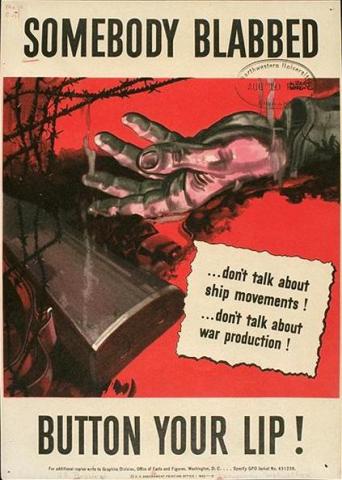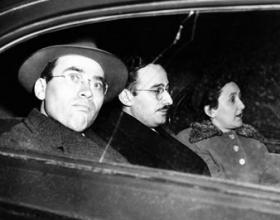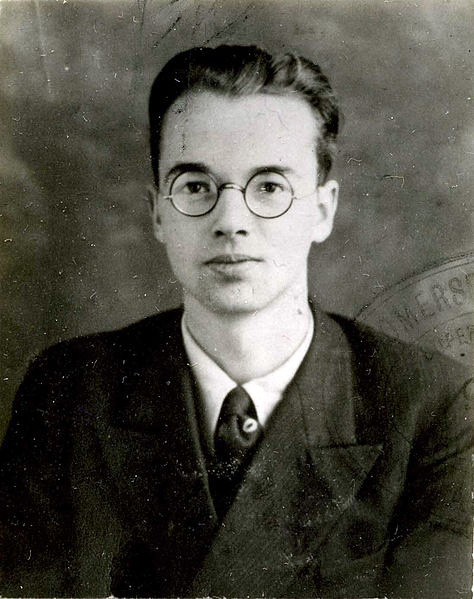Espionage was one of General Groves’ main concerns during the Manhattan Project. For all of the attention paid to secrecy and counter-intelligence, spies were still able to penetrate the project and steal information about the atomic bomb. The Manhattan Project was infiltrated not by its enemies Germany and Japan, but by the Soviet Union. Soviet spies occupied positions of trust and importance in the Manhattan Project, and passed on valuable information about the bomb and its design.
Venona Project
The United States Army Signal Intelligence Service’s (SIS) Venona Project discovered Soviet espionage in the Manhattan Project. The Venona project took place between 1943 and 1980. The SIS created the counterintelligence program, with the goal of decrypting messages sent through intelligence agencies of the Soviet Union (the NKVD, the KGB, and the GRU). The SIS obtained and decrypted nearly 3,000 messages. The majority of the messages were decrypted between 1942 and 1945.
In 1943, the deputy Chief of Military Intelligence, Carter W. Clarke, initiated the Venona project because he distrusted Stalin and feared that the Soviet Union and Nazi Germany would conduct secret peace negotiations. The original goal of the Venona Project was to “examine, and possibly exploit encrypted Soviet diplomatic communications.” Code-breakers at SIS headquarters at Arlington Hall were responsible for decoding Soviet trade messages that were encrypted using an unbreakable “one-time pad” system. For three years, cryptanalysts struggled to decipher Soviet trade traffic. The breakthrough came in 1946, when it was discovered that some of one-time pad keys had been reused by the Soviets, which allowed decryption (sometimes only partial) of a small part of the traffic.
Collecting the cables was easy and decoding them proved to be the challenge. The Soviet cables proved to more difficult to read than Clarke had expected. On December 20, 1946, cryptologist Meredith Gardner first broke into the Soviet code and by this point World War II had ended. As portions of the transcripts were decoded over the coming years, American officials were shocked by what they discovered. The Soviets had penetrated almost every branch of the United States government and had spies in important positions within the State Department, the Department of the Treasury, the Office of Strategic Services (OSS), and even the White House.
Over the next decade, the United States Army and the Federal Bureau of Investigation worked closely to try and determine the identities of Soviet spies referred to in decrypted cables by cryptonyms, or secret codenames. By 1950, officials had identified Harry Dexter White, a high-ranking Treasury Department official; former White House economic adviser Lauchlin Currie; and OSS division head Maurice Halperin. The decrypts also revealed a number of Soviet spies at Los Alamos, including David Greenglass. The atomic secrets obtained allowed for the Soviet Union to develop atomic weapons sooner and cheaper than it otherwise would have.
In April 1951, the Venona code breakers discovered vital clues that helped lead to the discovery of the Cambridge Five spy ring in Great Britain. The Venona documents remained secret, and were only known and used by select government officials. The documents were declassified in 1995. The declassified documents also revealed that Julius Rosenberg led a Soviet spy ring. The involvement of others in Soviet spy rings such as Theodore Hall and Russell McNutt was also revealed through the declassified documents.
The major spies who revealed secrets of the Manhattan Project were:
Theodore Hall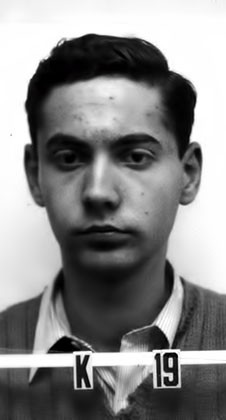
Theodore (“Ted”) Hall was born on October 20, 1925 in Far Rockaway, New York City. At a young age, Hall demonstrated considerable aptitude in mathematics and science. In 1944, he graduated from Harvard at the age of 18, and was the youngest scientist to be recruited to work on the Manhattan Project at Los Alamos. In October 1944, Hall visited the Communist Party of the United States of America’s office in New York. Hall eventually met with Sergey Kurnakov, a military writer for a Soviet paper, and and passed him a report on the scientists who worked at Los Alamos and the basic science behind the implosion bomb.. Hall was code-named “MLAD” (“Young”).
After World War II, Hall left Los Alamos for the University of Chicago, where he continued to pass along information to the Soviet Union about the in-development hydrogen bomb. Hall was never convicted of, or even charged with, espionage. In 1997, Hall admitted that he felt strongly that an American monopoly on nuclear weapons was perilous and that atomic information should be shared between countries. He died in 1999.
George Koval
George Koval was born on December 25, 1913 in Sioux City, Iowa to a family of immigrants from Belarus. In 1932, the Great Depression caused Koval’s family to relocate to the Soviet Union, where they joined a collective farm. Koval was recruited by the Soviet Union’s Main Intelligence Directorate (G.R.U.), assigned the codename “Delmar,” and received specialized training to carry out espionage missions in the United States. In 1939, he returned to New York City to command the G.R.U. post there.
In August of 1944, he was drafted into the Army’s Special Engineer Detachment (SED) and sent to Oak Ridge, where his position as a Health Physics officer gave him top-secret clearance. Koval passed secret information about Oak Ridge’s nuclear facilities to a Soviet contact, code name “Farraday.” In June 1945, Koval was transferred to Dayton, Ohio, where he obtained and passed information about the polonium-based “initiator” for the implosion bomb that was being developed.
In 1946, Koval was honorably discharged from the Army. In 1948, he sailed for Europe, never to return. He died peacefully at his home in Moscow on January 31, 2006. On November 2, 2007, Russian Prime Minister Vladimir Putin posthumously awarded Koval with the Hero of the Russian Federation Medal, the nation’s highest civilian honor, for “his courage and heroism while carrying out special missions” and acknowledged Koval’s contribution to the Soviet Union’s development of the atomic bomb.
For more information about Koval, check out “The Spy Who Stole Urchin” by Owen Pagano, an intern at the Atomic Heritage Foundation who became interested in Koval and wrote his undergraduate thesis on the topic.
Morton Sobell
Morton Sobell was an American electrical engineer who stole information from his employer, General Electric, and passed it along to the Soviet Union. He was implicated in the same Soviet spy ring that included Julius and Ethel Rosenberg. After accusations of his espionage emerged in 1950, Sobell and his family fled to Mexico, but were later kidnapped by armed men and returned to the United States, where they were turned over to the FBI. In 1951, Sobell was tried and convicted of espionage and was sentenced to thirty years in prison. He was released after serving seventeen years and nine months. Sobell maintained his innocence for much of his life. In 2008, at the age of ninety-one, Sobell told the New York Times that he did in fact turn over military secrets to the Soviets during World War II.
David Greenglass
David Greenglass was born in 1922. He was the younger brother of Ethel Rosenberg. In early 1943, he and his wife Ruth joined the Young Communist League. Greenglass was assigned to work on the Manhattan Project in July 1944 as a member of the Special Engineer Detachment. Initially stationed at Oak Ridge, Tennessee, he was transferred to Los Alamos in August 1944 where he worked until February 1946. An Army sergeant and skilled machinist, Greenglass was on a team tasked with making molds for the high-explosive lenses used to detonate the plutonium core in the implosion bomb.
In November 1944, Greenglass and his wife, Ruth, were recruited by his brother-in-law, Julius Rosenberg, to spy for the Soviet Union. In the middle of 1945, Greenglass sent Rosenberg a crude sketch and twelve pages of detailed notes on the implosion-type bomb.
In June 1950, Greenglass was arrested. In February 1951, he testified that Ethel had typed the information that Julius later passed on to the Soviet Union. In so doing, Greenglass secured immunity for Ruth, which allowed her to remain with his children while he served a prison sentence. His testimony ultimately proved decisive in the conviction of the Rosenbergs, who were executed in the electric chair on June 19, 1953. Greenglass was released from prison in 1960. He died in New York in 2014.
Julius Rosenberg
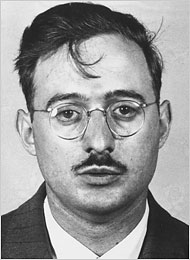
Julius Rosenberg was born on May 12, 1918 in New York City. Politically active from an early age, he joined the Communist Party in 1939, the same year he married Ethel Greenglass.
In 1940, Rosenberg joined the U.S. Army Signal Corps as a civilian engineer, and later became an inspector. By 1942, he had become involved in espionage for the Soviet Union. According to his Soviet handler, Rosenberg provided numerous classified documents, including a model of a proximity fuze. Rosenberg was also involved in attempting to recruit others to spy for the Soviet Union, including David Greenglass. Greenglass passed details about the Manhattan Project to Rosenberg, including information about the high-explosive lenses being developed for the implosion bomb.
Early in 1945 Julius was fired from his job with the Signal Corps when his past membership in the Communist Party came to light. On June 17, 1950, he was arrested after being implicated by Greenglass. Throughout their appeals, he and Ethel maintained their innocence. They were executed at Sing Sing prison in New York on June 19, 1953.
Ethel Rosenberg
Ethel Greenglass Rosenberg was born into a family of Jewish immigrants in New York City on September 28, 1915. After graduating from high school, she became an active member of a workers’ union organizing strikes and protests and joined the Young Communist League. Through her activism and engagement in the Communist Party, she met Julius Rosenberg.
In his controversial testimony against the Rosenbergs at their trial, David Greenglass reported that his sister Ethel had typed the notes her husband passed to the Soviet Union on the American bomb project. Ethel was executed, shortly after her husband, at Sing Sing on June 19, 1953.
Six decades later, the execution of the Rosenbergs remains a controversial subject. Recently declassified documents have reignited debate over Ethel’s alleged role in the Soviet spy ring. It was the testimony of David Greenglass in the 1951 trial which implicated Ethel, but before a secret grand jury in 1950, Greenglass affirmed, “I said before, and say it again, honestly, this is a fact: I never spoke to my sister about this at all.” This testimony was not made available to the defense lawyers at the Rosenbergs’ trial.
Furthermore, a Venona Project intercept from 1944 mentioned the recruitment of Ruth Greenglass, the wife of David Greenglass, but made no mention of Ethel Rosenberg. In later interviews, David Greenglass stated, “I frankly think my wife did the typing, but I don’t remember” and “My wife is more important to me than my sister.” Ruth was never charged.
Michael and Robert Meeropol, the children of Julius and Ethel Rosenberg, maintain Ethel’s innocence to this day and have created an online petition to exonerate her.
Klaus Fuchs
Klaus Fuchs was born in Rüsselsheim, Germany in 1911. In 1930, he joined the German Communist Party. After the Nazis came to power, Fuchs fled to England in September 1933 to avoid persecution. He received his Ph.D. in physics in 1937. In May 1941, Rudolf Peierls, co-author of the Frisch-Peierls memorandum, invited Fuchs to join the British atomic bomb research project, codenamed “Tube Alloys.” In late 1943, Fuchs was part of a British delegation of scientists sent to Columbia University in New York to work on the Manhattan Project. In particular, he worked on developing the gaseous diffusion method of uranium enrichment.
Fuchs was transferred to Los Alamos in August 1944, where he worked in the Theoretical Division under Hans Bethe and Edward Teller. There, he calculated the approximate energy yield of an atomic explosion and specialized in researching implosion methods. Through his courier Harry Gold, Fuchs passed detailed information about the atomic bomb to the Soviet Union.
Following the end of the war, Fuchs returned to England and continued his work on the British atomic bomb project. Arrested in January 1950, Fuchs confessed to being a Sovet agent and served nine years in prison. After his release, he moved to East Germany, where he died in 1988.
Harry Gold
Harry Gold was an American laboratory chemist who served as a courier for a number of Soviet spies during the Manhattan Project, including Klaus Fuchs. Involved in the Communist movement since the 1930s, Gold was recruited as a Soviet agent in 1940. He helped Fuchs pass information about the Manhattan Project to the Soviet Union. Implicated by Fuchs in 1950, Gold confessed, leading to the arrest of David Greenglass and the Rosenbergs. Sentenced to thirty years in prison in 1951, Gold was paroled in May 1965, after serving just under half of his sentence.





